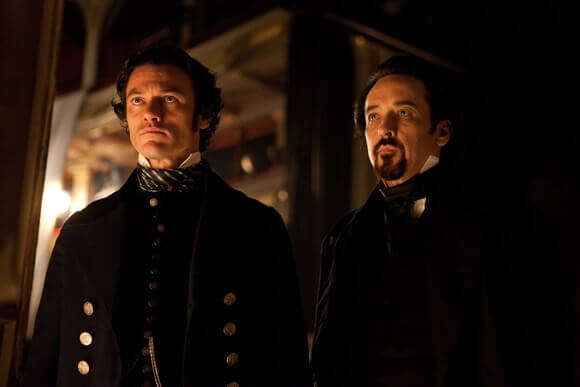Watch The Raven trailer:
Relativity chose to release The Raven trailer today, October 7th, because it’s the 162nd anniversary of Edgar Allan Poe’s mysterious death. And to celebrate Poe’s life, Relativity’s put together a packet of background information on both the film and Edgar Allan Poe.
About Edgar Allan Poe [Courtesy of Relativity Media:]
· Poe wrote a fabricated news story of a balloon trip across the ocean to garner attention and publicity in New York City.
· Poe was a champion for higher wages for writers and international copyright law, as his writings were continuously published without him getting credit or compensation.
· Prior to becoming Poe’s wife at the age of 13, his female cousin Virginia acted as a courier, delivering letters to Poe’s lady loves.
· From 1949 to 2009, a mysterious figure has left a half-empty bottle of cognac and 3 roses on Poe’s grave every day on his birthday.
· Poe formulated rules for the short story, including that it should relate a complete action and take place within one day in one place.
· Poe was deeply interested by cryptography, the creation and translation of secret codes, and was very proud of his ability to translate them. He would challenge readers of various publications where he worked to send him codes to decipher and, by all accounts, he seemed able to unlock the secrets to any he received.
· Poe’s lifelong dream of owning and operating his own publication never came to fruition.
· Poe met with Charles Dickens while Dickens was in the US on a lecture tour, and solicited his help with getting published in England—nothing ever came of it.
· Poe’s grandfather was an important figure in the American Revolution, contributing a large sum of his own money to outfit local branches of the Continental Army. His wife, Poe’s grandmother, personally sewed over 500 soldiers’ uniforms for Lafayette’s troops as they passed through Baltimore.
· Poe joined the Army in 1827, lying to recruiters about his age and name. He also published his first collection of poetry during this time. He achieved the rank of Sergeant Major.
· Poe experienced periods of extreme destitution, often having to burn his furniture to keep warm during the winter.
· Poe successfully sought expulsion from West Point. That being said, he was one of the top students in his class.
· Wrote poetic tributes to all the pivotal women in his life.
· Poe had two biological siblings, but all were raised in separate foster homes.
· Poe’s childhood hero was Lord Byron.
· The Poe House and Museum in Baltimore is in jeopardy of being closed in mid-2012 due to Baltimore City budget cuts. The city eliminated the Museum’s funding in 2010.
Edgar Allan Poe’s Body of Work:
“A Dream” (1827)
“Evening Star” (1827)
“The Happiest Day, the Happiest Hour” (1827)
“The Lake. To” (1827)
“Song” (1827)
“Stanzas” (1827)
“Al Aaraaf” (1829)
“Fairy Land” (1829)
“Romance” (1829)
“To The River” (1829)
“Sonnet – To Science” (1829)
“Spirits of the Dead” (1829)
“The City in the Sea” (1831)
“The Sleeper” (1831)
“Israfel” (1831)
“Lenore” (1831)
“The Coliseum” (1833)
“Manuscript Found in a Bottle” (1833)
“The Assignation” (1834)
“Berenice” (1835)
“Hymn” (1835)
“Bridal Balad” (1837)
“Sonnet – To Zante” (1837)
“Ligeia” (1838)
“Silence – A Fable” (1838)
“The Fall of the House of Usher” (1839)
“The Haunted Palace” (1839)
“Sonnet – Silence” (1840)
“The Murders in the Rue Morgue” (1841)
“William Wilson” (1842)
“The Conqueror Worm” (1843)
“The Gold Bug” (1843)
“The Angel of the Odd” (1844)
“The Balloon Hoax” (1844)
“Dream-Land” (1844)
“A Descent Into The Maelström” (1845)
“Hop-Frog” (1845)
“The Black Cat” (1845)
“The Facts in the Case of M. Valdemar” (1845)
“The Man of the Crowd” (1845)
“The Purloined Letter” (1845)
“The Purloined Letter” (1845)
“The Raven” (1845)
“The Valley of Unrest” (1845)
“Eulalie” (1845)
“The Cask of Amontillado” (1846)
“Ulalame” (1847)
“Eureka” (1848)
“Annabel Lee” (1849)
“The Bells” (1849)
“Eldorado” (1849)
“For Annie” (1849)
“Mesmeric Revelation” (1849)
“A Dream Within A Dream” (1850)
“A Valentine” (1850)
“Eleonora” (1850)
“The Imp of the Perverse” (1850)
“The Island of the Fay” (1850)
“The Masque of the Red Death” (1850)
“Never Bet the Devil Your Head” (1850)
“The Oval Portrait” (1850)
“The Pit and the Pendulum” (1850)
“The Premature Burial” (1850)
“Some Words With a Mummy” (1850)
“The Spectacles” (1850)
“The System of Dr. Tarr and Prof. Fether” (1856)
“The Tell-Tale Heart” (1850)
“Bon-Bon” (1850)
“Elizabeth” (1850)
“Loss of Breath” (1850)
“Serenade” (1850)
“The Domain of Arnheim” (1850)
“Alone” (1875)
“The Devil in the Belfry” (Unknown)
“Imitation” (Unknown)
About The Raven [Courtesy of Relativity Media]:
Edgar Allan Poe (John Cusack) joins forces with a young Baltimore detective (Luke Evans) to hunt down a mad serial killer who’s using Poe’s own works as the basis in a string of brutal murders. Directed by James McTeigue, the film also stars Alice Eve, Brendan Gleeson and Oliver Jackson-Cohen.
When a mother and daughter are found brutally murdered in 19th century Baltimore, Detective Emmett Fields (Evans) makes a startling discovery: the crime resembles a fictional murder described in gory detail in the local newspaper—part of a collection of stories penned by struggling writer and social pariah Edgar Allan Poe. But even as Poe is questioned by police, another grisly murder occurs, also inspired by a popular Poe story.
Realizing a serial killer is on the loose using Poe’s writings as the backdrop for his bloody rampage, Fields enlists the author’s help in stopping the attacks. But when it appears someone close to Poe may become the murderer’s next victim, the stakes become even higher and the inventor of the detective story calls on his own powers of deduction to try to solve the case before it’s too late.







